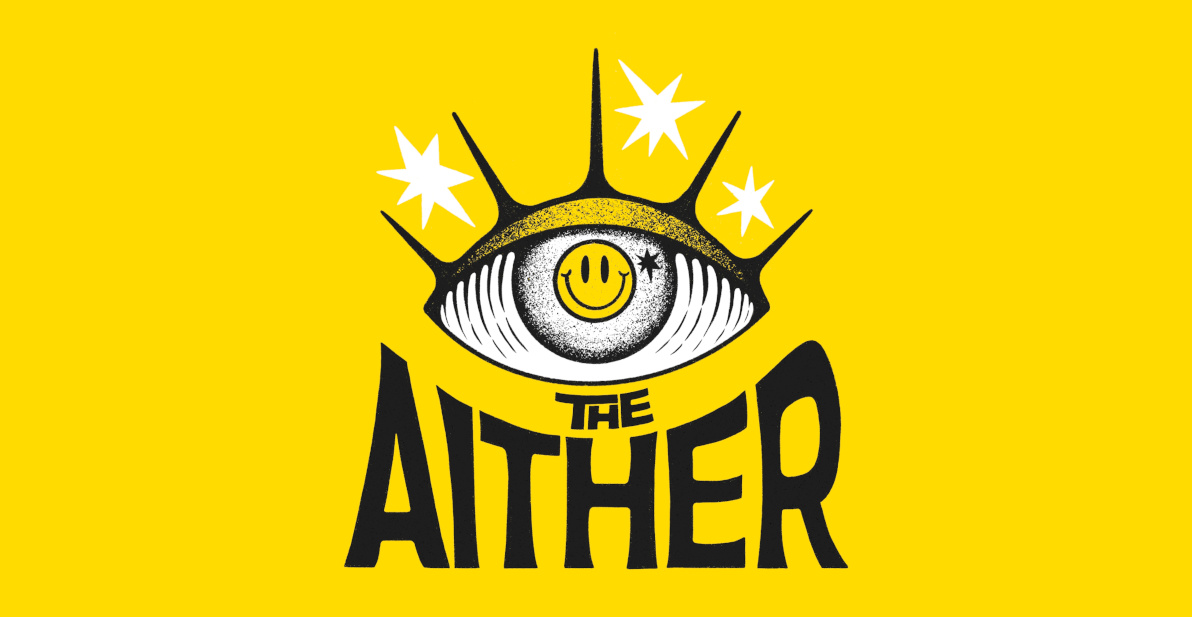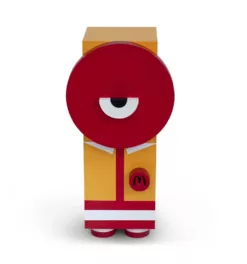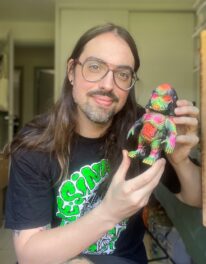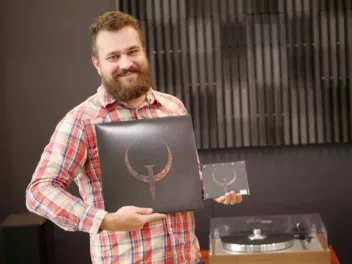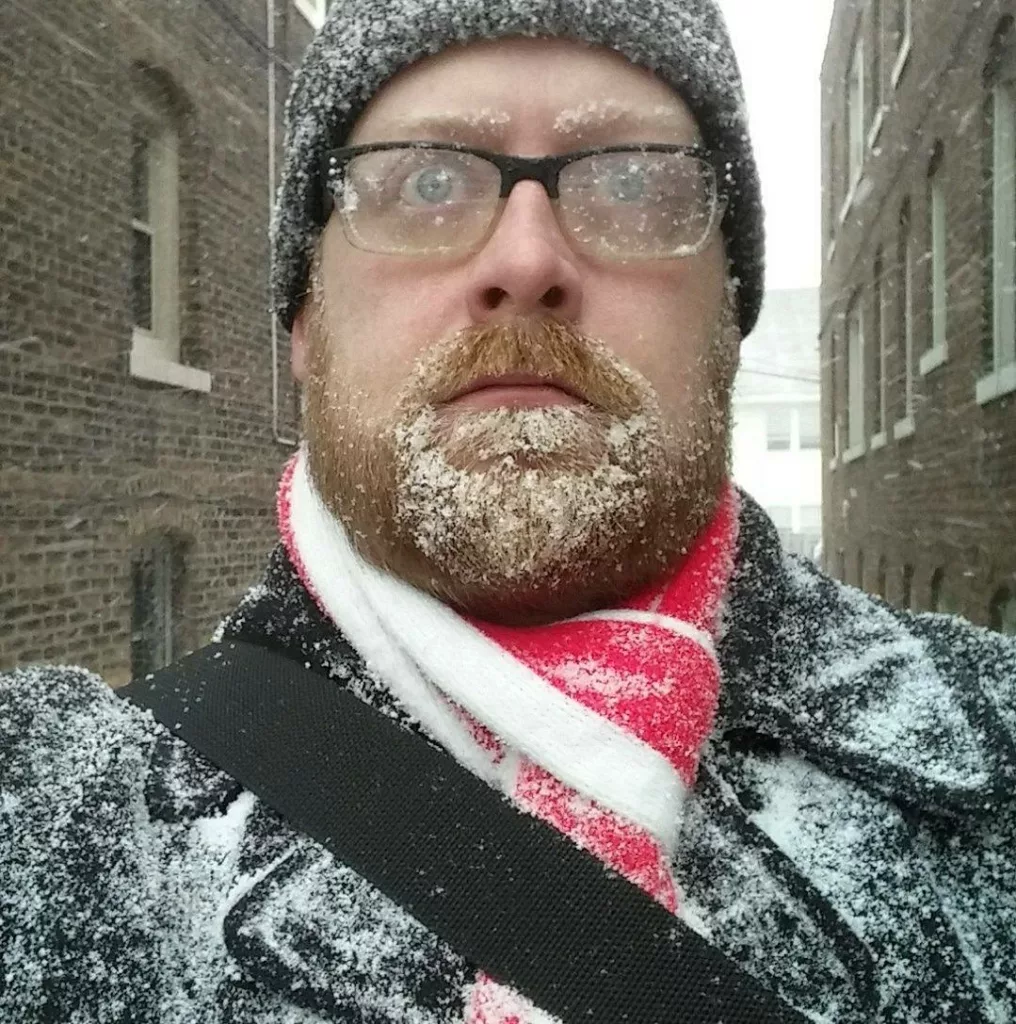
It’s a determined man who drags the Cuyahoga River‘s storied waters and comes up with treasure the way today’s subject does with his true crime comics series DEATH, DESTRUCTION, VICE, and SLEAZE – though for Jake Kelly, taking the plunge and getting dirty for art’s sake is all in a day’s work.
One half of new(ish) publishing imprint Stone Church Press, alongside co-founder Aaron Lange, Jake is to Cleveland, Ohio’s DIY scene as Da Vinci is to the Renaissance. His work – in everything from fliers and comix; to murals, furniture painting, and most recently publishing – makes him as much a noteworthy figure as the subjects of his meticulously researched graphic histories.
He’s that rare producer of both quality AND quantity. His defiantly analogue M.O. making that distinction all the more remarkable.
If there’s a single word that summarizes the many other descriptors I could list in order to describe Jake’s output, it’s PURE. Nothing in the guy’s vast oeuvre strikes as if it were driven by anything but the satisfaction of putting art back into the world.
Whether through his art & writing, or conversation, getting Jake’s angle on his city is like hearing someone talk about a lifelong best friend, albeit a slightly fucked-up one. With whom better to entrust Cleveland’s deepest, darkest secrets?
Here, to help answer that question, is the only Jake Kelly that matters.
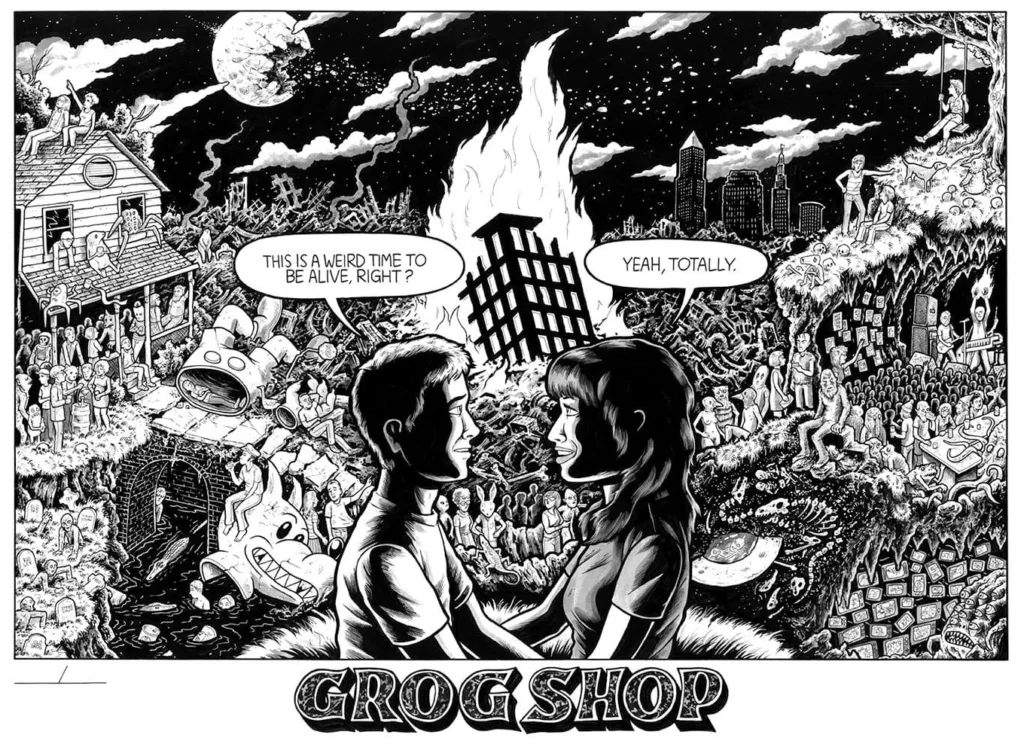
DH: Welcome, Mr. Jake Kelly, underground comix author, illustrator & publisher, muralist, furniture painter, historian, and connoisseur of slaw dogs.
Did you know there are multiple Jake Kellys out there calling themselves artists? On YouTube alone I stumbled across two of them, one being an art photographer from England and the other some kind of cocktail whiz.
JK: I wish all the Jake Kellys out there good luck.
Decades ago, the jakekellyart.com domain was taken by a terrible oil painter. When I checked the domain recently, it was a bizarro Chinese website or something that was a work of fit-inducing glitch-art unto itself.
DH: You’re the Jake Kelly from Cleveland, yes?
The Jake Kelly responsible for drawing thousands of show posters over the past 25-or-so years?
The one who, along with painting dozens of murals across the eastern United States co-created The Lake Erie Monster comic book series (with John G.) and, just last year, co-founded Stone Church Press?
JK: Technically, Cleveland Heights. I’ve moved on up to the East Side.
But yeah, that’s me, guilty as charged on all counts.
DH: And if I asked you about your DEATH, DESTRUCTION, VICE, and SLEAZE books, you’d know what I was talking about?
JK: It depends on how many of Jake Kelly’s cocktails I’ve had, ha ha… But I think so!
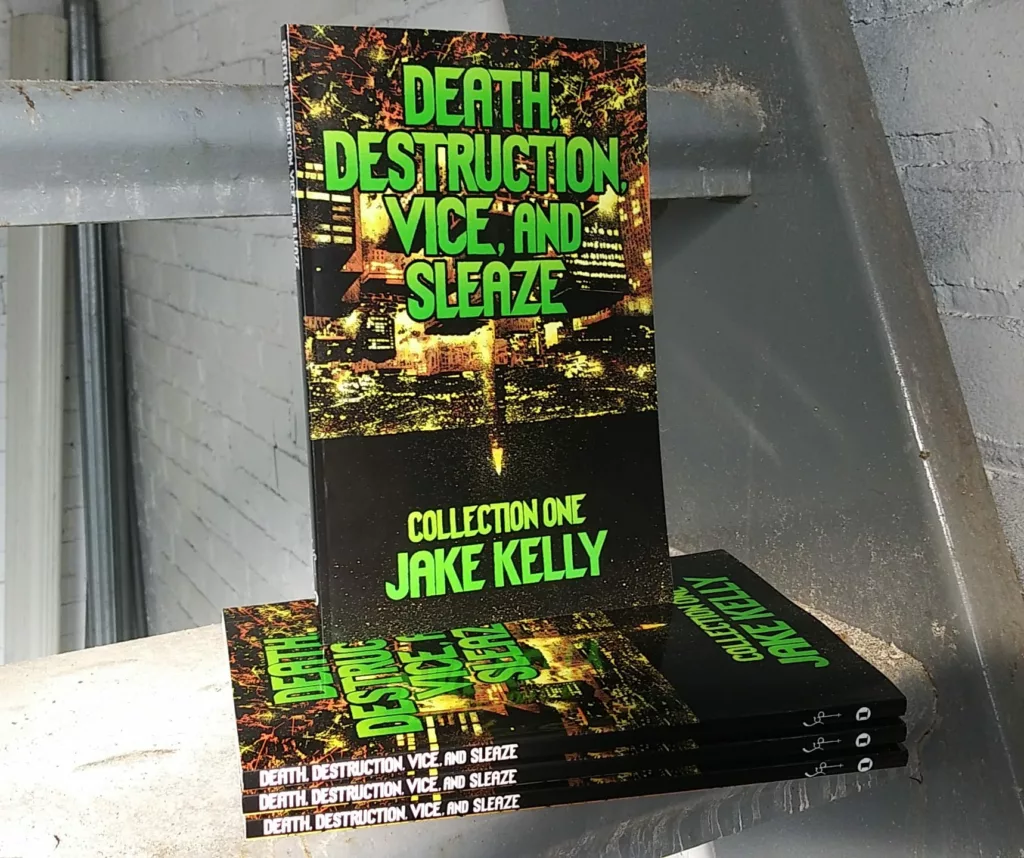
DH: Works for me!
Let’s fill in a few blanks and come back to that...
For a guy with as much work under his belt as you have, there appears to be pretty little information out there regarding your early life.
Can you give us a sense of your experiences growing up?
What were you doing before you got into art in earnest?
JK: There was never a time in my life that I wasn’t into art in earnest, or at least into drawing in earnest. Obsessively might be a better term. When I could hold a pencil, or a crayon, I started drawing.
My dad was into comics when he was a kid so he’d buy a box of random, beat-up old comics at the flea market and dole those out to me as rewards for picking up my clutter, helping out, whatever, before I could even read. They had an immediate, transcendent effect on me at, like, age four. I could comprehend the story even though I couldn’t understand what was going on in the pointy balloons.
When I was too young to think, I decided that all I wanted to do was draw and for better or worse, I’m still doing exactly that.
My early life otherwise? I was born in Florida in 1978, we moved around a lot, my parents got divorced when I was in third grade, the usual adolescent troubles of the modern world.
I heard The Ramones in fifth grade and thought “I draw, and I’m a PUNK…” ha ha. That was the second decision, made very early, that has defined my existence.
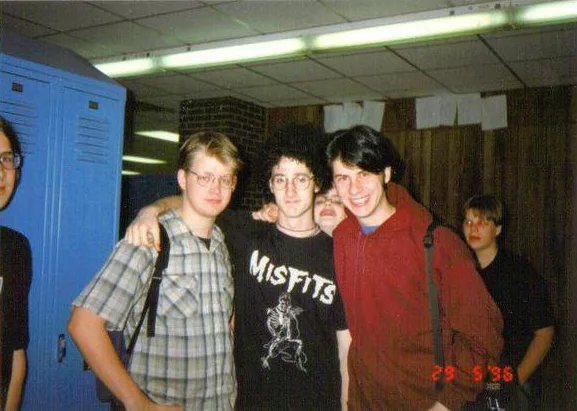
DH: Fast forward to the mid-90s – You’ve been artistically active in a number of ways since then, perhaps most famously for your gig posters, having been in and around punk bands during those early years.
Can you talk about how your productivity in that time put you on the creative and professional path(s) you’d eventually end up on?
JK: The punk scene that I came up in, and the larger hovering ideas, were all about DO IT YOURSELF, ya know? Book your own fuckin’ life. And I’m like, 13, 14, whatever.
The very first fanzine I ever saw was called Steel Metal Condom and it was so bad, so shitty in every way, that I thought “I can FOR SURE make something better than this,” and I did. The zine I made was terrible, but we’re grading on the Steel Metal Condom scale! I saw Cometbus, Dishwasher, Doris, Grumblefuck, Craphound, and so-so-so many other great zines not too long after that.
You don’t know what the fuck a zine is, then you get really into zines, ya know? And I then understood what a GOOD fanzine was. Then my friend Stephe and I started collaborating on the zines and they got better, maybe actually good at some point. Also, I got obsessed with stealing photocopies for a while.
Music, of course, was central to my life in those teenage years, so OF COURSE I had to have a band. Which became bandS. There were a few, some better than others, all very fun, and of course I drew or did a cut-and-paste flier for our shows.
And I tried to steal the photocopies if I could.
It’s weird, but photocopy scamming was a major part of my, and several of my friends’ lives.
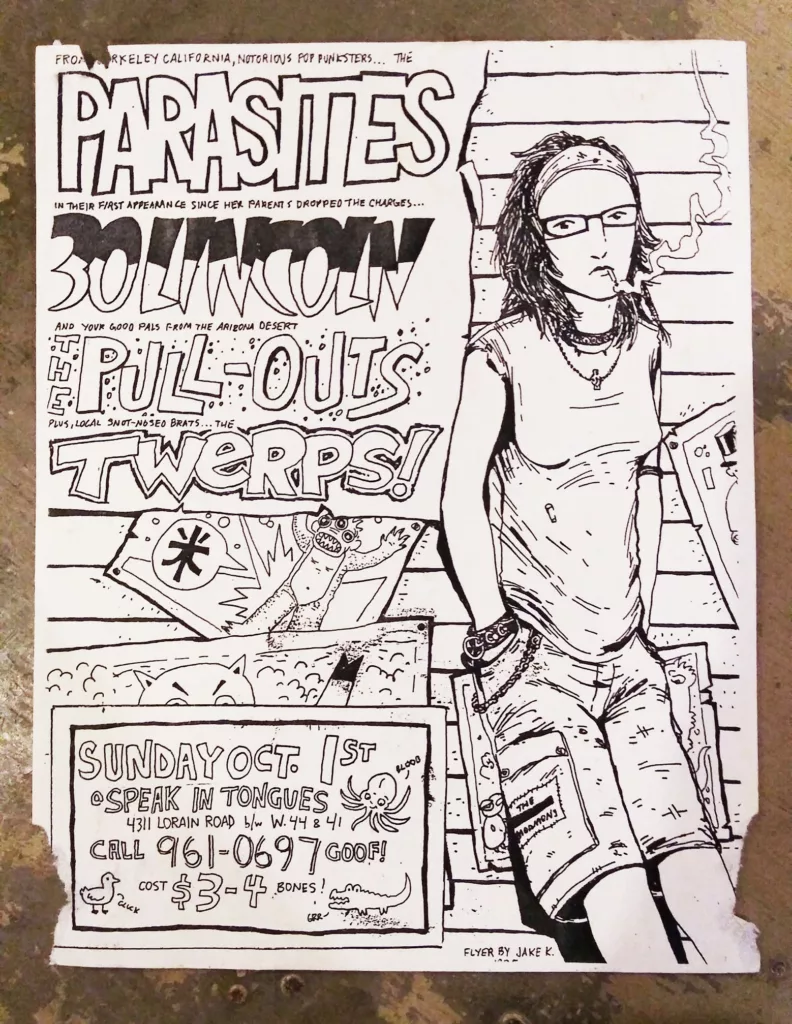
Anyway, all this led me to living, not long after graduating high school, at a place called Speak In Tongues.
It was a very anarchic storefront DIY illegal showspace in a neighborhood called Ohio City in Cleveland’s near West Side. There’s an oral history of that place just recently published by Microcosm Books that I was interviewed for and it’s the kind of place you could read 3,000 oral histories of and never really get it unless you were there.
The Microcosm book is great, though!
Anyway, I did fliers for shows there, and I used a little portfolio of those fliers to get paying flier gigs at the two cool, legit clubs in town: the Beachland and the Grog Shop. That was maybe 1999 and both of those clubs are still around! I got paid $20 a flier. In 1999, that was bus fare, a pack of cigs, a nice dinner at Steve’s Hot Dog Lunch, a jug of Carlo Rossi Paisano, with a little cash left to play with.
So it was all set from an early age: publishing, a DIY ethos, drawing, fliers, petty crime, etc, etc, etc.
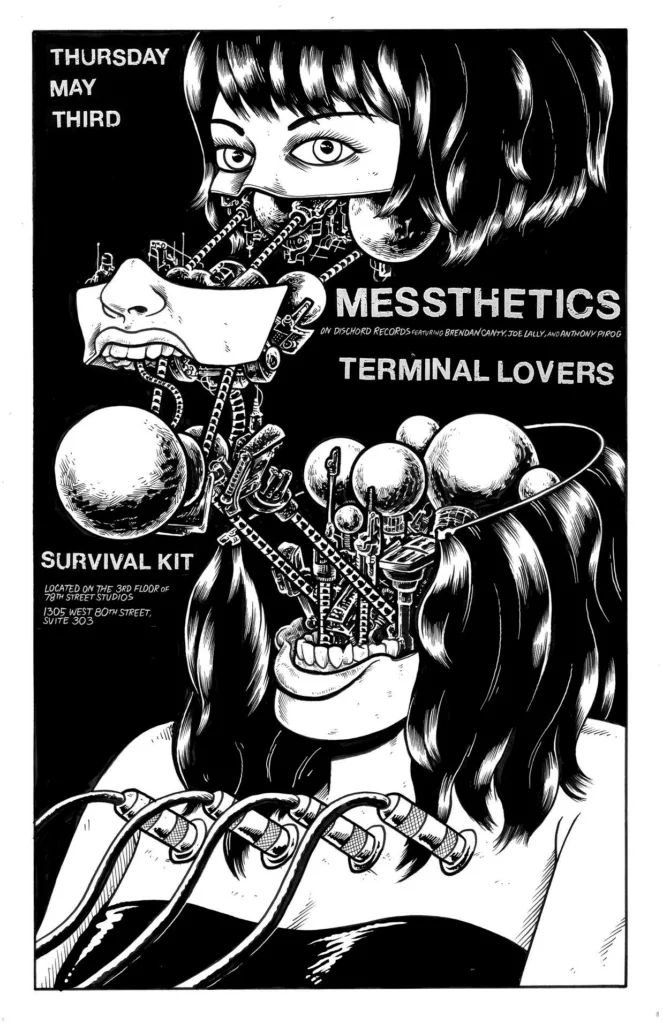

DH: You’ve cited poster artists like Dave Cintron, Clay Parker, and Derek Hess as influences, although flicking through Volumes 1 & 2 of your (enormous) self-published FLIERS collections, my mind goes to the black & white comics art of various 90s cartoonists.
Are there any comics artists whose work you’d say you took after, earlier on?
JK: I was a Swamp Thing OBSESSIVE when I was a kid, so John Totleben and Bernie Wrightson and Steve Bissette were huge influences.
Totleben had this exquisite line, it seemed like it was made by a machine.
Bissette had a weird frenzy about him, he was dictating all this crazy panel architecture and crazy poses.
Wrightson, what can ya say? There’s never enough black ink. There’s a shape, coming outta the shadows, you can’t quite make it out. He drew scary drawings good.
They’re all three masters that I think about to this day.
I got into all the EC guys later, when the Gladstone doubles were being sold at the grocery store.
Crumb, obviously, showed ya that there are no rules.
Clowes and Burns were huge, Clowes probably more for his venom than his drawing but aren’t they inseparable?
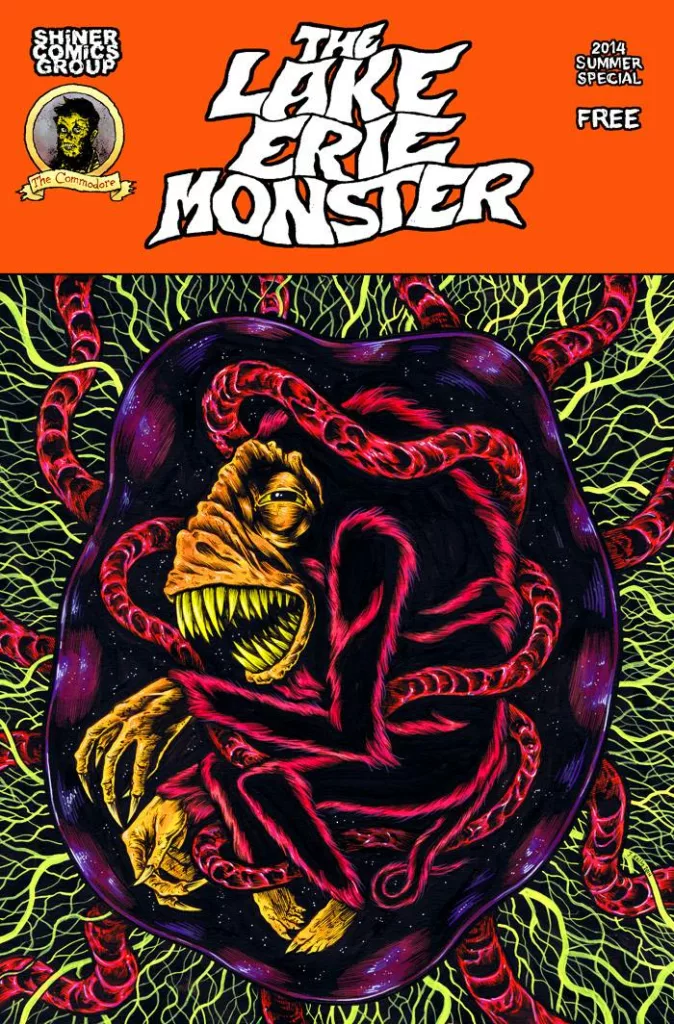
DH: That makes perfect sense, actually.
Of course, in the years since making a name for yourself as a veritable flier-producing machine, you’ve earned your chops not just in the world of underground comix, but as an accomplished painter, too.
Am I wrong, or do I remember you saying somewhere that you bluffed your way into your first paid mural job?
JK: It’s 2003 and I’d been doing fliers (8.5 x 11) for the Grog Shop for a few years and they were moving to a new location, up the street, same block, on the corner. The owner, Kathy, asked me if I’d ever done a mural before. I said “Of course I have!” and that was a lie. I’d never drawn anything larger than 11 inches by 17 inches and this was FOUR feet by SIXTEEN feet.
I dropped acid and did the initial drawing, then started drawing this (at the time) huge mural. It was a learning curve, or a learning corner, but I got it done.
I don’t advise people to lie and say YES in occupations like air traffic control, but if someone asks you if you’ve ever done a mural, say yes and do the mural they’ve got you in mind for. If you can’t do it and you flame out, well, you’ve got a funny story for 10 years from your abject failure.
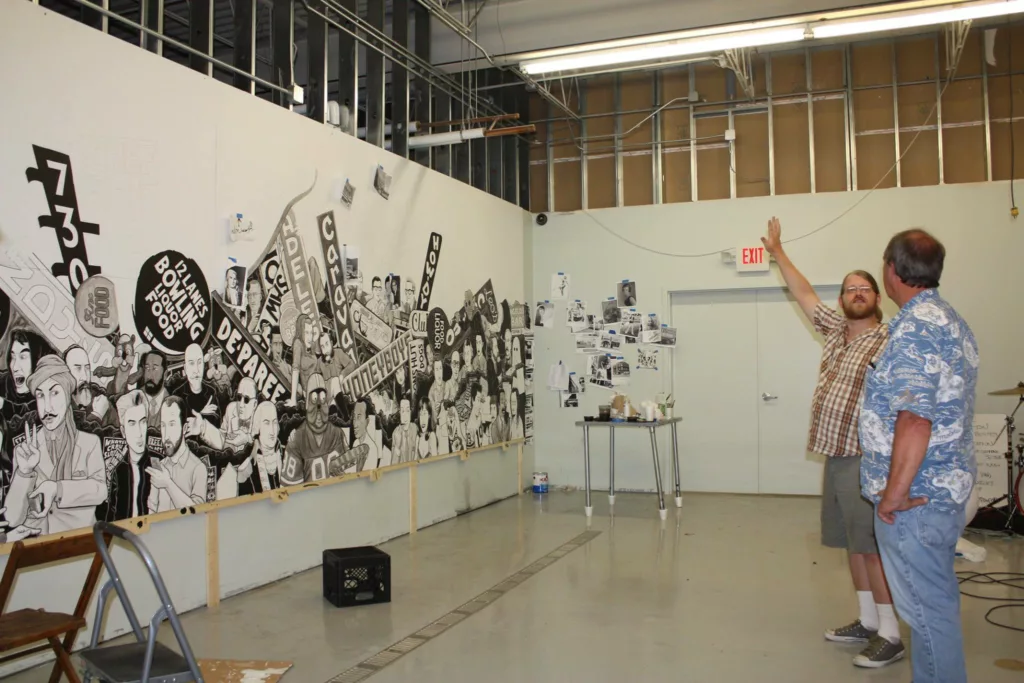
DH: It ain’t every cartoonist that commits to working in both small and large scale the way you’ve been able to.
Is there a factor common to either of those mediums (a capacity for storytelling, for example) that keeps you equally interested in both?
JK: I always thought of many of the fliers and posters as advertising something that’s about to happen, THE SHOW, so when I did something ‘comic book-y’ I tried to make the flier seem like the middle panel in a three panel comic strip.
“There was some lead-up we missed in panel one, and here’s some weird shit on this flier, and it seems like some weird shit is about to happen, maybe let’s go to this show?”
So I tried to insinuate the idea that THERE’S A STORY HERE into these divorced, static images.
I went from the 4ftx16ft mural, over the years, to a SIXTEEN-foot-tall wall that was FIFTY-FOUR feet wide, and the big carry-over was that there has to be narrative. I’m talking about my murals for Melt Bar and Grilled now, and those were always crazy crowd scenes and I always made a point that every single person had some little bit of business they were doing or they seemed somehow involved in some larger, unknowable story.

DH: I see some of those ideas going on with furniture you’ve painted, too – You have an uncanny knack for finding the potential in any and all surfaces to become a functioning comics panel!
Are there specific ways you’d say experimenting with each of those ‘disciplines’ furthers your skills in the other?
JK: When I’m drawing comics, all I wanna do is draw a mural, when I’m on a mural all I can think about is the comic.
I’d need a few hours to talk about that so let’s move on.
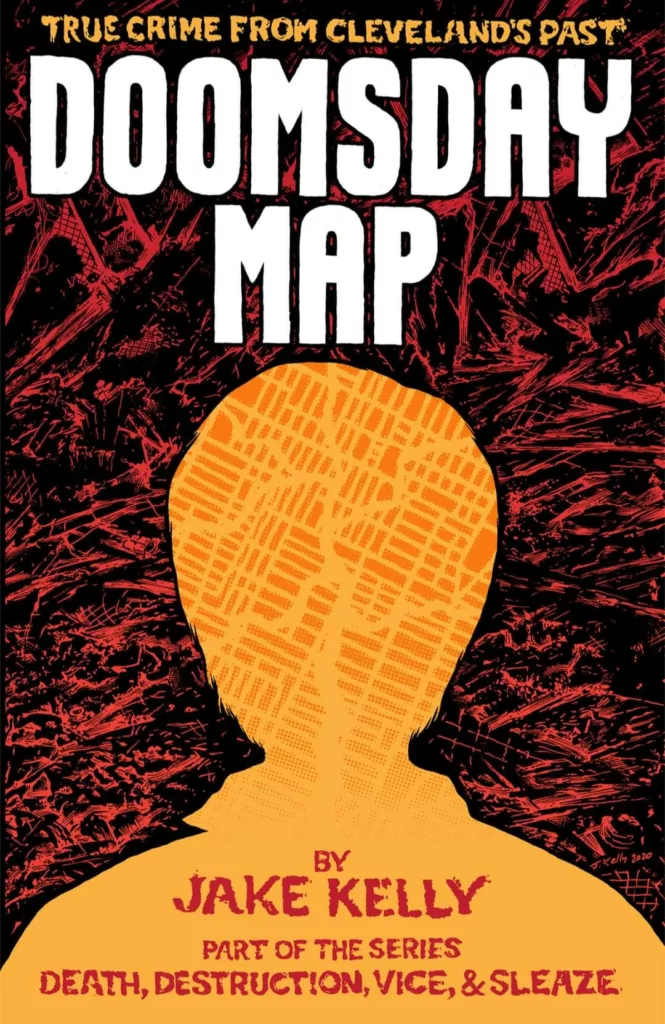
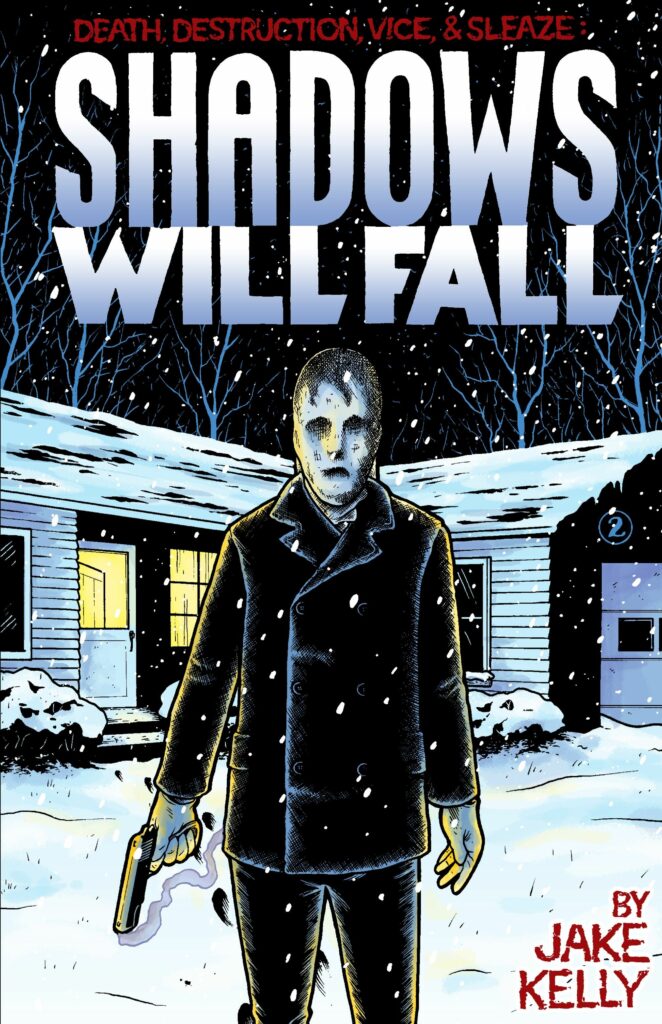
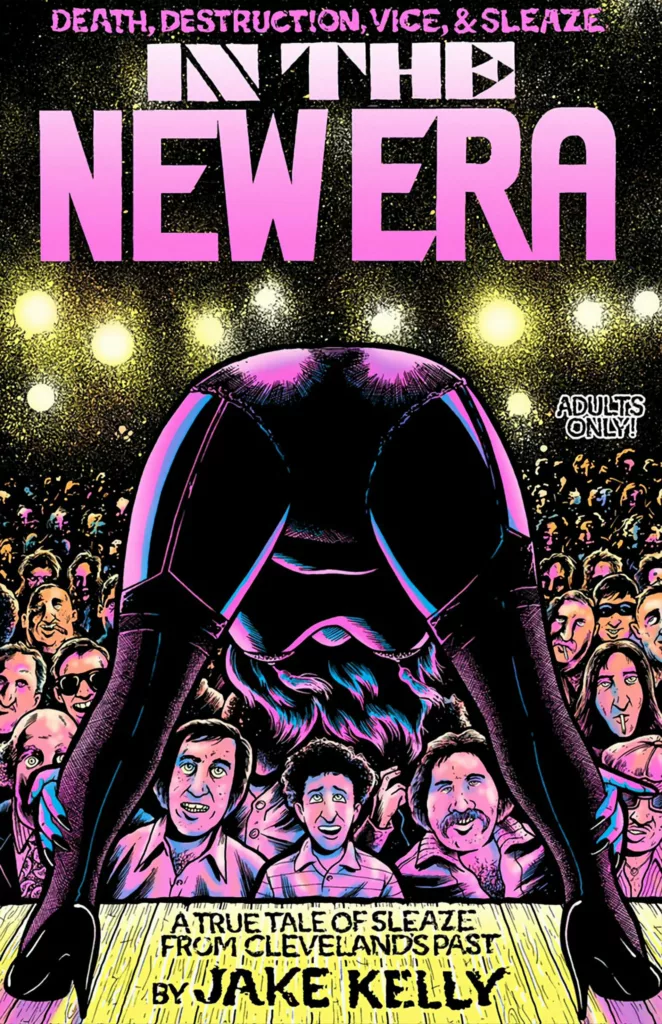
DH: Well, whatever those artful hands have gained from all that contact with the real world, it’s made them uniquely qualified to produce the work I’m most looking forward to picking your brain about today: your true crime & history comix saga, DEATH, DESTRUCTION, VICE, and SLEAZE.
In 2022, a volume collecting DDVS’s first three issues, ‘Doomsday Map,’ ‘Shadows Will Fall,’ and ‘In The New Era’ dropped alongside an ambitious new fourth issue, ‘Blowing Minds,’ and, put simply, every page of each title is VERY good shit.
How far back does your interest in exploring and documenting Cleveland’s sordid past go?
JAKE: I’ve always loved weird, outsider, and underground history. Cleveland has plenty of weird and dark history, and I’ve been interested specifically in the 1970s here for a long while, dating back to a series of articles I wrote for my zine about the history of vice and sleaze here.
It’s a strange nexus of pornography, bombs, outlaw biker wars, organized crime, murder, corruption, and some of the farthest out punk rock that the early 70s ever birthed.
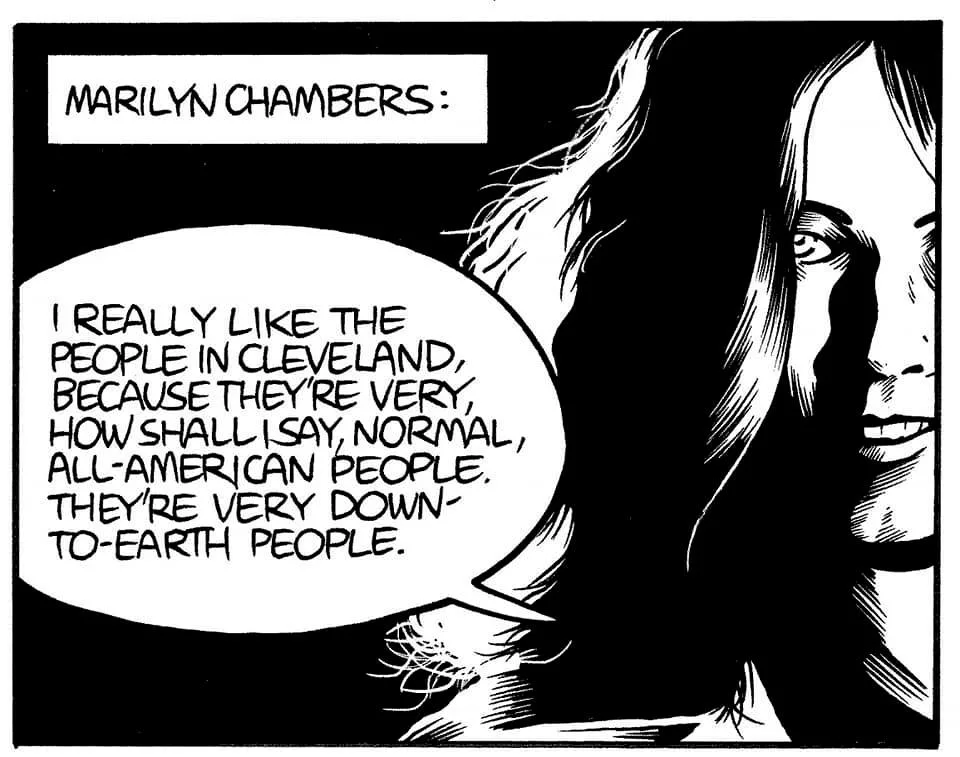
DH: Though the larger portrait you paint is complex, each of DDVS’s parts is thoroughly readable in a way that feels very original among comics I’ve seen, which attempt to capture ghosts of Americas bygone.
Your narration presents a sort of collage, not (just) of images, but of written records, perspectives and voices– It all lends a unique ‘documentarian’ spirit to your picture of Americana.
Who, from outside of the comics medium, do you take cues from in your approach?
JK: I take that as a great compliment; I try to make these like little documentary comics. So, outside of comics, documentary films are a big (one) for me, just trying to see how people put together words and images and the construction of a story.
I’m trying to think of some good documentaries that I’ve watched that are sort of true crime, or true crime adjacent:
Voyeur (2017) was very good, very well made and had some nice twists and turns.
Who Took Johnny (2014) is a plunge into darkness.
Tickled (2016) was very good, and reminded me a bit of Errol Morris’ movies, a wild ride that will take massive turns into the unexpected.
And obviously Errol Morris is a genius and in addition to his movies his book, A Wilderness of Error was a huge influence on me. A one-of-a-kind reading experience, the docu-series they made based on it could not hold a candle to it.
Another book would be Going Clear: Scientology, Hollywood, and the Prison of Belief by Lawrence Wright; a huge influence. He was able to synthesize such a massive amount of information and tell a true story that seems so crazy it has to be fake.
Weird Scenes Inside the Canyon by David McGowan is fantastic, an absolute barrage of information that puts you in a state where you do not know, nor do you care, if it’s true.
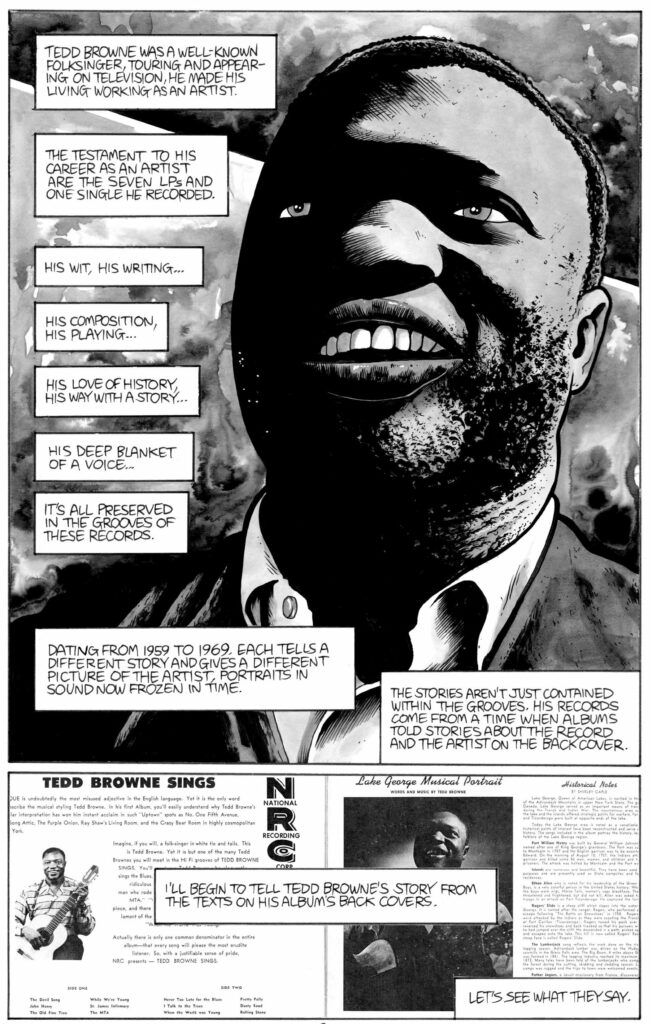
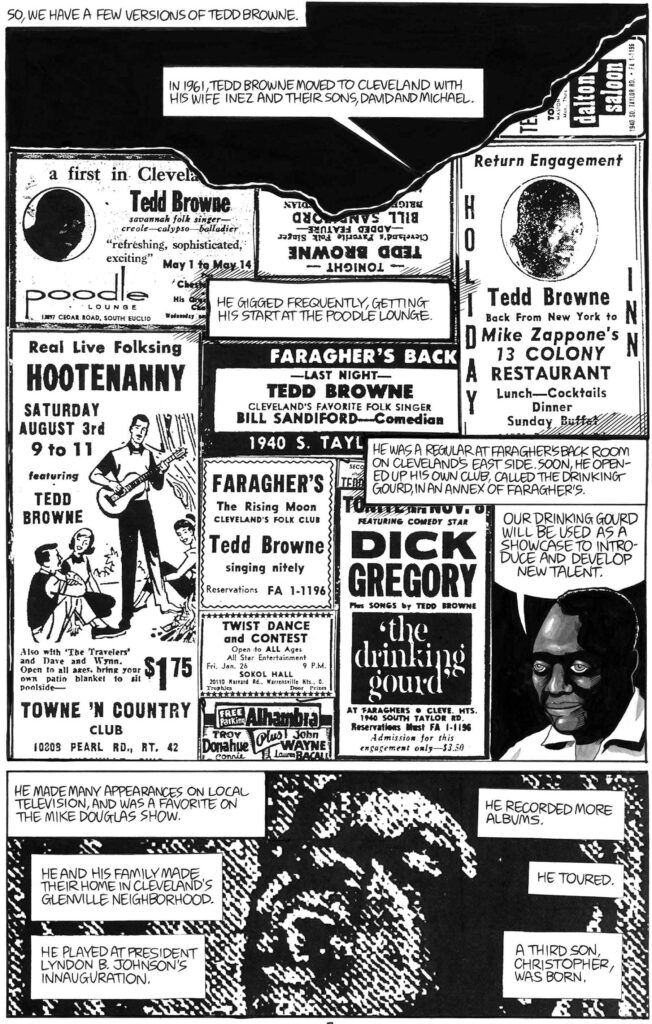
DH: I can totally see examples like those being indispensable references.
Between your writing and your art, a sense of the time spent studying up for DDVS is tangible, if not emphasized – There’s a layer to these stories that puts us right there with you, xeroxing reference books and scrolling through old microfilm reels in some darkened corner of the city library.
I actually recall you saying elsewhere that Cleveland’s city library is one of your favorite places on earth, and that really comes out in these books.
Would you say the processes your research requires, the practicality it demands, has been as much an inspiration to your art in DDVS as the stories themselves?
JK: So, at the start of this project, I had a sort of rough idea of what events I wanted to cover in this story and I made a very basic outline, then headed down to the library to look through some microfilm.
It’s always a nice day out, you take the train downtown to this incredible, beautiful, library. It’s this wonderful depository of Cleveland history, and I met my friend Aaron there.
I searched for a few different things, found some good stuff, and was excited about this project. Then, on a lark, I grabbed the Jan-Feb-1970 microfilm from the Cleveland Press newspaper. I’m doing a book about Cleveland in the 70s, why not start at the beginning and just start reading? I didn’t get too far before I discovered this kid who blew up a suburban police station, and I mean he destroyed it. I’d never heard this story, and this happened one city over from the city I live in, literally on the same road I live on. And I made that story the first chapter, because it ended up being the perfect kick-off, given what I had planned.
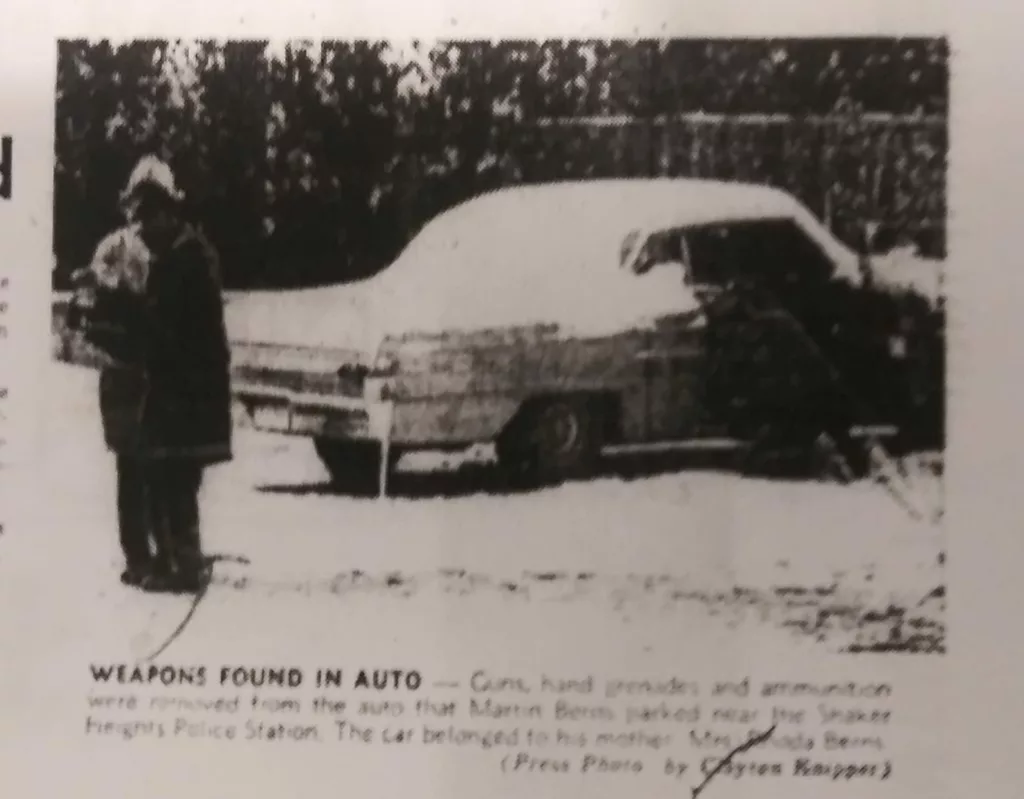
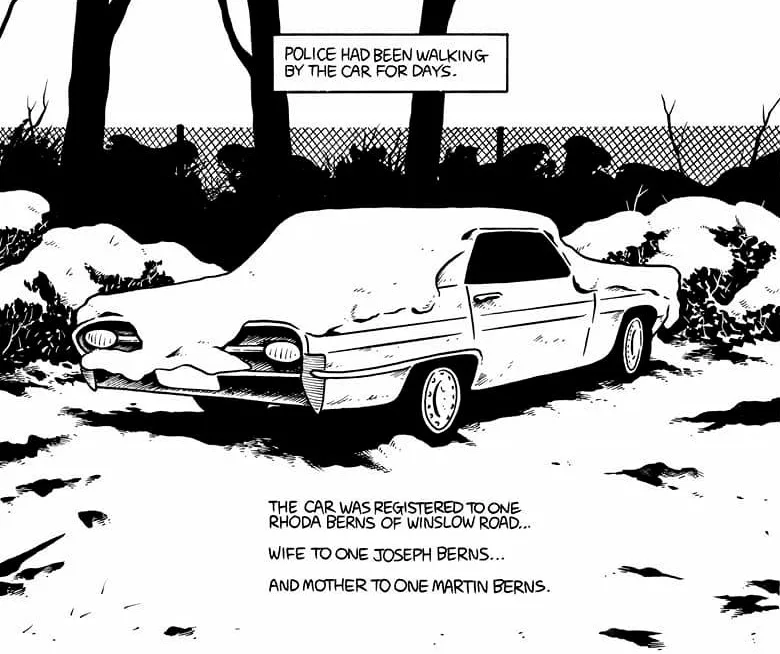
You don’t always get that lucky, though, and more to your question: It’s all rabbit holes that go nowhere, and all those rabbit holes connect to rabbit holes that DO go somewhere, ha ha.
I’ve gone nuts trying to find out who owned some sham oil concern in the 1970s or track some Go-Go bar where a suspicious number of murders happened. I’ve sent many, many, many unanswered Facebook messages, called so many disconnected numbers, and had emails bounce back “address unknown” more times than I can count.
I LIKE doing this, though: I view it as mapping the territory, seeing how big the rabbit warren actually is, and making note of all the dead ends, just in case I need to return there someday.
Maybe I can figure out a way to dig through that wall, y’know?
DH: What kind of obstacles or setbacks come with diving deep like you do?
Have you had trouble confirming versions of events?
How much do you owe in library fines?
JK: I definitely try to present the most correct version of events, but I’m also happy to let people lie and not correct them. In the comic, there’s my narration, and then there’s what people are saying or said in the papers. These may not always link up, and the capital-T-Truth may be somewhere in between.
I like the water to be a little muddy, I guess.
The research is the most time-consuming part of all of this.
First, you have to figure out the story, that’s a ton of reading and rabbit holes. Then you have to stock the comic with accurate images. That’s a massive amount of work and reading some reference to an outfit someone wore can make me go into an obsessive spiral, trying to find some weird shoe that was referenced or whatever.
I do miss making comics where I made shit up and drew what I knew.
Oh, and I owe $3.20 because I’m not quite done with Early Settlers of Cleveland by William Ellis (1976).
They may have to bust down my door to get that book back!
DH: Seeing the way the first few of issues come together as the first DDVS collection, it feels like these stories could just as easily have been packaged as an overpriced hardcover ‘graphic novel’.
Can you say why you’ve preferred to release shorter, episodic entries?
JK: Have you seen Bill and Tedd’s Bogus Journey? At the climax, they have to play a song that unites the world but they haven’t had time to write the song so they hop into a time machine, zap away, spend a few years writing the song, then zap back and perform the song, only seconds later.
When I planned out this story, my version of the story of Cleveland in the 1970s, I knew it would take years to research, write, and draw. I had also laid out a fluid framework, where I allowed for new stories to insert themselves when, like, new information came to light. Lacking a time machine to zap away with, I figured I’d put them out as pamphlet comics, release each chapter as I get it done. Also, I figured putting this out into the world would help it build, and maybe people would start contacting me with stories to tell. And that has happened!
I like to think of the comics as little time-bombs that sit on toilet tanks ‘til the right person picks them up. Making zines, drawing fliers, singing a song onstage in front of an audience: it all points to releasing the chapters as I finish them.
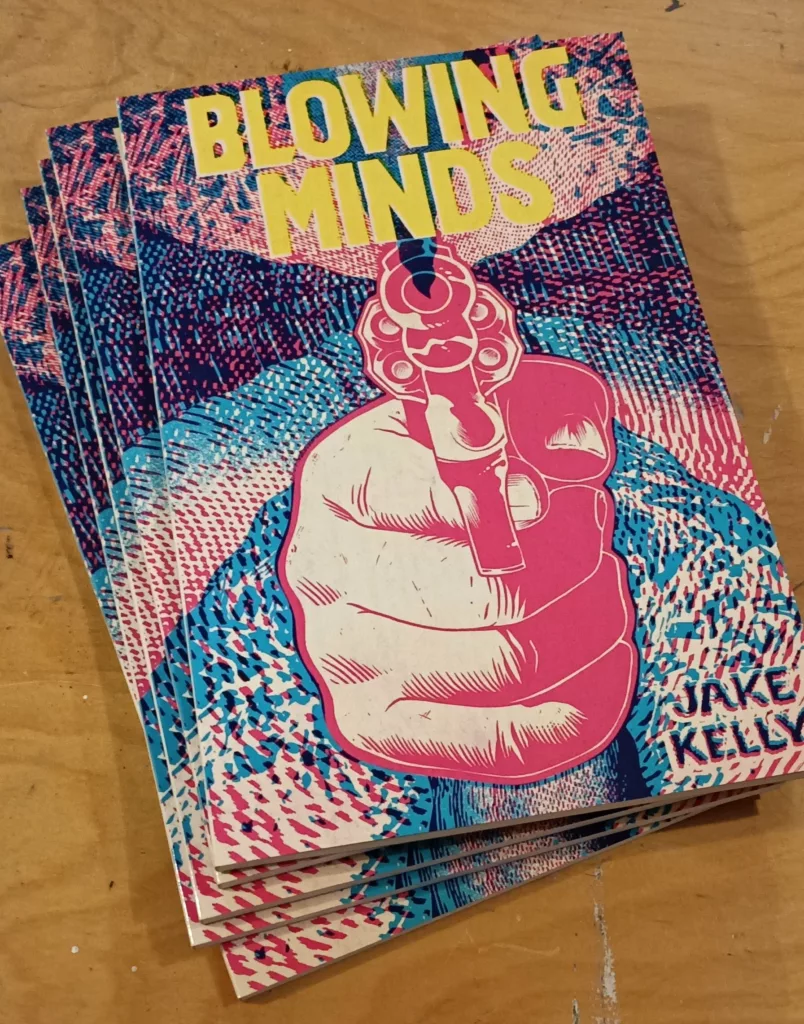
DH: If the first three issues of DDVS were The Jake Kelly Show, Blowing Minds is The Jake Kelly MOVIE. Indeed, the densely layered plot calls for such vivid layouts as we get in BM, but there’s an intensity to these pages that goes beyond that of any of your previous art.
Did the potential for this specific subject matter to take you into unchartered stylistic waters factor into your choosing to work with it?
JK: Well, I sort of planned it all out beforehand that this would be the fourth issue, because I knew that it would be extremely involved and I wanted to get three issues under my belt before I tried to tackle it so I would have a lot of pages in the can and I’d have some chops.
It’s definitely the most complex story with the biggest… “cast” sounds wrong, but the biggest number of players in the story. And the subject matter- cycle clubs, LSD, international drug rings – called for some far-out shit that I knew I’d need to have some road behind me before I started it. Blowing Minds, of course, is just a preamble to the next issue, ha ha! That one has Nazis, far-left terrorist groups, crazed Maoists, mad bombers, insane obscenity battles, and so much more, and I don’t think I could be writing that without having done Blowing Minds.
I am moving from “The Jake Kelly Movie” to Cecil B. Demille EPIC territory, with a cast of thousands, ha ha!
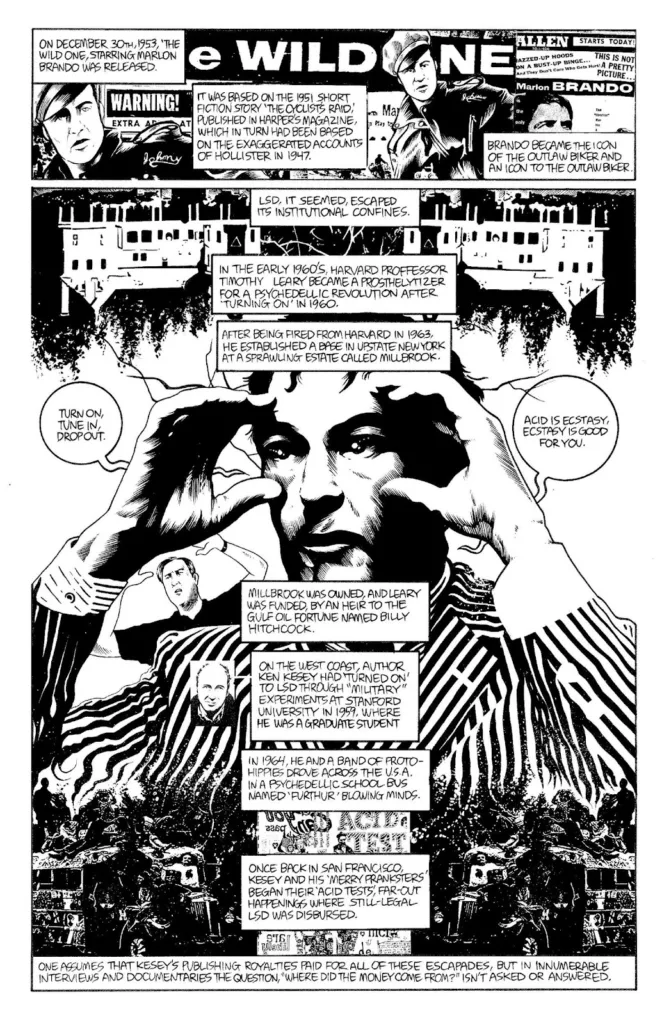
DH: BM’s descriptions of LSD’s effects range from dizzying and abstract to sober and cautionary, and appear infused with an educated, apparently personal perspective on the psychedelic experience.
How much did your own history with acid inform your representations of it throughout the book?
JK: I had quite the love affair with LSD and it was very helpful to me.
I really, actually, learned how to draw on acid. I’d take acid alone, put on something like Ride the Skies by Lightning Bolt on headphones, and just draw, draw, draw.
If you’ve done LSD, you may read some of the descriptions of the drug in the book with a cocked eyebrow. There are some of-the-era representations that may seem like an anti-drug fantasy, but hopefully the drawings get across that the artist was a major acid-head at one time, ha ha.
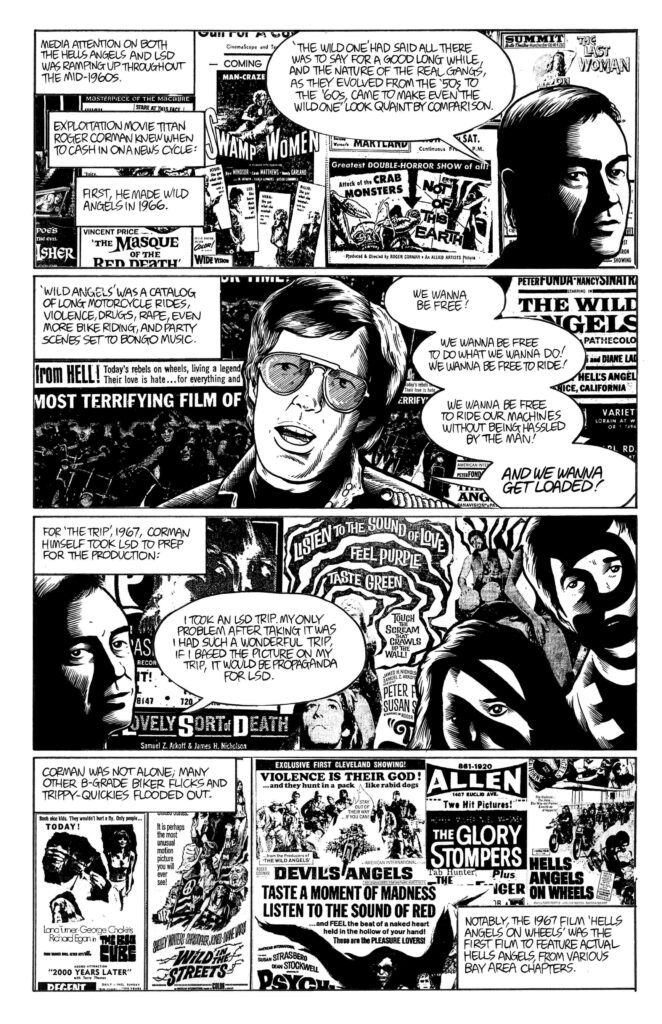
DH: Something – maybe THE thing – that makes BM feel so massive is how it connects Cleveland folklore with better known accounts of outlaw culture in 20th century America; as it adds to DDVS’s ongoing narration, it builds on such “required reading” as Tom Wolfe’s The Electric Kool-aid Acid Test and Hunter S. Thompson’s Hell’s Angels, for instance.
Is it important to you that Cleveland be acknowledged for the part it’s played in America’s hidden histories?
JK: Those two books are fantastic, seminal works. Tom Wolfe is, on most days, my favorite author.
I love street-level history, I love fucked-up true stories, and I love Cleveland. I love its dark veins and strangeness. I am not some Cleveland Cheerleader, though. I don’t want people to move here, I hate any kind of civic boosterism, and I don’t think Cleveland is especially dark or weird, at least in its pool of Midwest Rust Belt Sister Cities. I just live here, and I know these stories, and the archives and survivors are close by.
It’s like having a mutant for a parent, and lots of other people have mutant parents.
I was talking to an artist I was working with on a mural job in Pittsburgh named Mike Budai. He is a brilliant guy, great artist, hilarious, and we had very similar backstories: DIY punk spaces, drawing gig posters, and obsession with 70s crime and porno and general weirdness. There’s a DEATH, DESTRUCTION, VICE, and SLEAZE: PITTSBURGH out there in the aether, Mike just has to write and draw it. I mean, shit, I was on vacation on Tybee Island in Georgia, and there’s a DDVS: TYBEE out there, so it’s maybe a matter of perspective.
To the first thing: I hope that this slots in somewhere in that massive sea of literature about outlaw culture, the underground, and crazy shit that actually happened.
I don’t know if you’ve heard Relative Unknown, Jackee Taylor‘s podcast series about her father, Butch Crouch, who was perhaps the most infamous Angel from the Cleveland club in the 1970s, but it is fantastic. It’s a wild, emotional ride. I only discovered it about halfway through working on Blowing Minds, and it sort of blew my mind.
If my book has to fit anywhere into the pantheon, I’d be happy if it was just the prequel to that masterpiece.
DH: These DDVS books hold the special distinction of being the first of yours to be published by Stone Church Press.
Does putting these books out stamped with that ‘SCP’ logo feel like reaching an important milestone, for yourself and for Stone Church?
JK: We are registered with the state, a legitimate business, so in that sense it’s the realest thing I’ve ever made.
DH: When I interviewed Aaron (Lange, Stone Church co-founder), he cited the confusing T&Cs of e-commerce platforms like Big Cartel and Shopify as a big factor in his wanting to start an imprint, and mentioned that you guys partnered-up because you shared those sentiments.
Of course, SCP is still in its early days, but has moving away from those platforms and conducting business on your own terms been freeing in the way you’d hoped?
JK: The specific note in Big Cartel’s terms of service that made me get froggy and jump was that you couldn’t glorify police.
I’m an anarchist, I am no fan of the state or their enforcers, but I am going to tell stories that glorify some individual cops. There are humans who did amazing things.
Could I somehow run into trouble if someone complains? WHO KNOWS!?
DH: Then there’s the matter of dealing with the comix-purchasing public in the real world!
You recently tabled at Genghis Con– how did newcomers react to the SCP buffet?
JK: Aaron and I were very happy with the convention overall, and while Aaron on principle does not have fun, I did! I was very flattered by the number of people who talked to me about my book, who’d read every issue, and it was all very nice.
We sold copies of everything, and I loved that.
People definitely responded to Brazilian Wax, so that was great. It’s the first non-Aaron/Jake release and people dig it.
DH: You guys have been on a roll so far with it all, SCP I mean. The new books all seem to be getting a bunch of love, and that all-important Patreon content has been consistently well worth checking out.
Are you at liberty to discuss any exciting new projects in the works at SCP?
JK: No.
DH: You brought up Steve’s earlier.
Your 2015 essay on the inferno that took the beloved diner, ‘Requiem for a Slaw Dog’, really makes clear the affection you’ve had and have for that and other parts of Cleveland along the line.
In that 2017 interview with Melt Bar & Grilled’s Matt Fish, you say “I don’t know what it is, but certain of us who live in Cleveland sort of develop an obsession with Cleveland.”
Have you figured out what “it is” yet?
JK: We had a lot of good punk bands and we have long winters, so maybe there’s something about the creatives here that they hole up during nasty winters, create, and listen to local music?
I don’t know, I just made all that up to have an answer.
But I will say: I can vividly remember a drawing marathon during a blizzard listening to Bender Season by Roue (my favorite Cleveland band) on repeat.
This city gets you into its grooves, and ya start to look at the walls sooner or later.
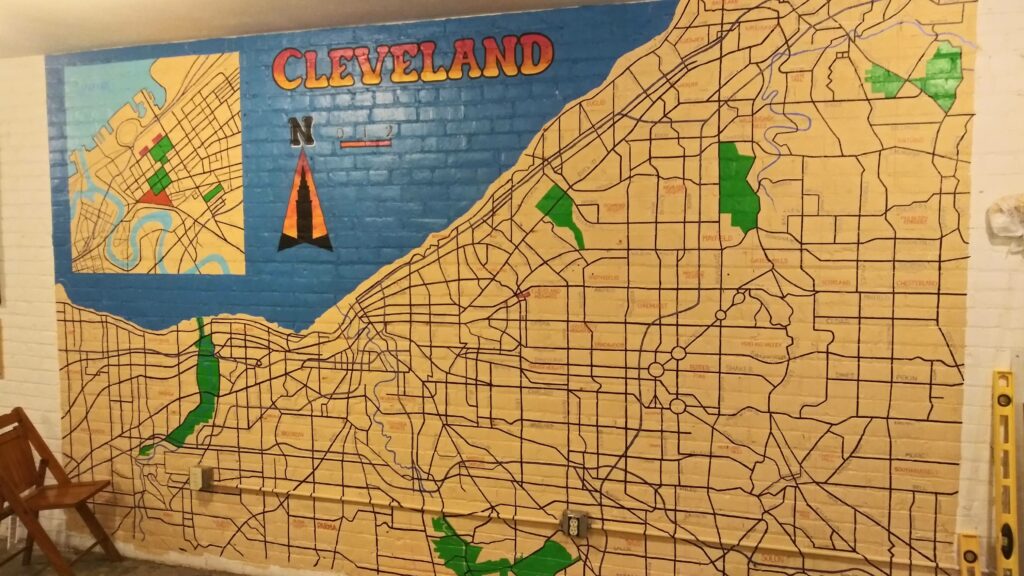
DH: Alright, I’m sure I’m keeping you from finishing at least a dozen different jobs you’re in the middle of, so let’s wrap this up with a final round of questions only the REAL Jake Kelly would know the answers to:
DH: Favorite Cleveland landmark?
JK: Lake Erie.
DH: Favorite Cleveland disaster?
JK: Both late 70s blizzards.
DH: Worst ‘public art’ in Cleveland?
JK: The state-funded “public art” world is a fucking nightmare that I will not unpack here, but I will say this: THE WORST IS YET TO COME.
DH: Part of the city in most desperate need of one of your murals?
JK: Whichever business wants one.
I don’t take city jobs!
DH: Worst online ‘print-on-demand’ service?
JK: I can’t answer that, really, and I don’t run people or companies down unless they really deserve it.
I’m not a REVIEWER.
DH: Best band you’ve made a poster for?
JK: Many such cases!! The Black Lips, Diarrhea Planet, the Growlers, Modest Mouse, Surfer Blood, Rozwell Kid.
I have some DREAM JOBS like Harlem or Old Dirty Bastard, but those will never happen now.
DH: Worst band you’ve made a poster for?
JK: I dunno, I didn’t go to shows for bands I didn’t like.
I did try to make them good fliers, though!
DH: Microfilm or Microfiche?
JK: I—- film.
NEXT QUESTION!
DH: Best Genghis Con?
JK: The first one.
That’s when I met Aaron and Liz Valasco. It was magical.
DH: Most consecutive hours spent drawing or painting?
JK: I think I did about 40 straight hours on the Melt Bar and Grilled Columbus mural. It was very detailed and I was painting it at my studio on panels and I had Adderall. I think I started drinking to “wind down” and probably touched up and made notes on the mural for another 8 hours. So 48-ish hours? I max out at 14 hours now. You start making mistakes and painting poorly, ya know? I have worked on a few mural crews with a guy named Brian Holderman, another Pittsburgh guy, and we were in Indianapolis painting a cool taco restaurant and we were talking about how long you should draw for. He set the endpoint at when you’ve been drawing for a long time and then ya make two or three fuck-ups: “Nothing cool is going to happen after that.”
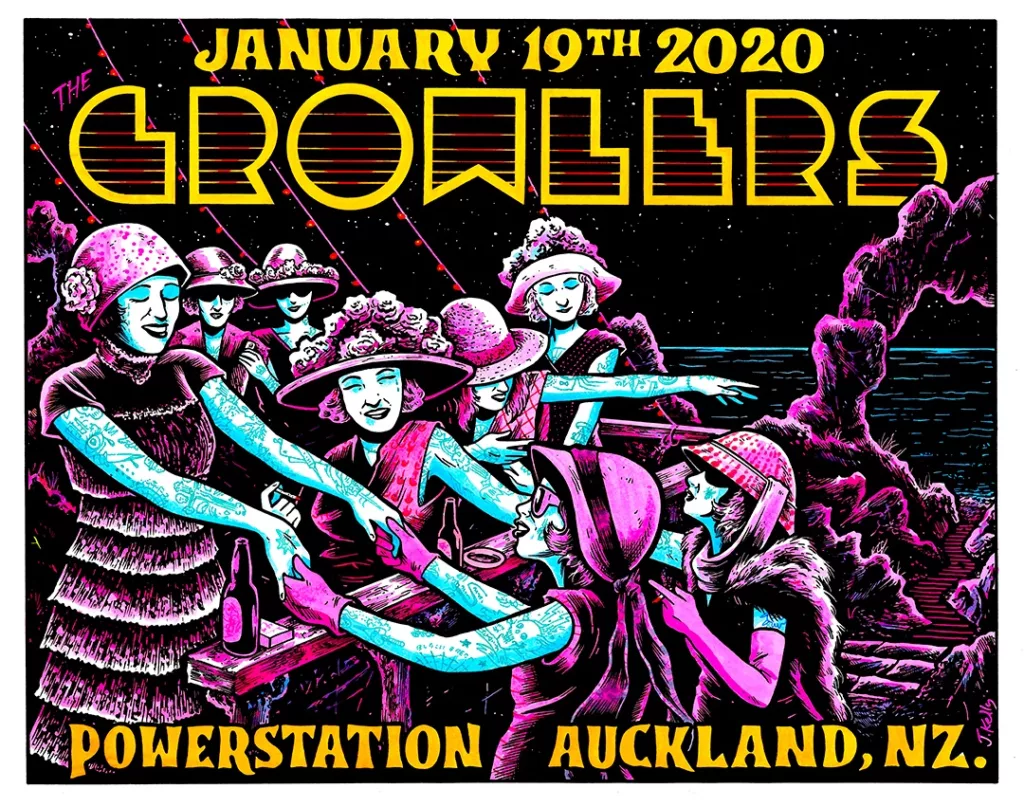
DH: Favorite picture from “Australia: Image of a Nation 1850 – 1950”?
JK: Too numerous to mention, but let’s say page 96. I’ve taken a lot of inspiration from that book! I used the photo on pg 210-211 for a Growlers poster for a show in New Zealand, a cheeky move I suppose.
The dozens of others are hopefully less obvious.
DH: Pen or brush?
JK: Pen for comics, brush for walls.
Open up dead ends between those two.
DH: Paper or bricks?
JK: Paper for screeds, bricks for business.
DH: Ok, I guess you’re the Jake Kelly I was thinking of.
JK: Are you trying to date me?
*CLICK*
Death, Destruction, Vice, and Sleaze: Collection One and Blowing Minds are available from Stone Church Press at stonechurchpress.com NOW. See more of Jake’s comics, murals and furniture on instagram at @jakekelly.art, and check out patreon.com/stonechurchpress to go even further down the rabbit hole.
Links
- Jake Kelly – Instagram
- Jake Kelly – 2017 interview with Melt Bar & Grilled’s Matt Fish
- Stone Church Press – Website & Online Store
- Stone Church Press – Patreon
All images supplied by Jake Kelly.
